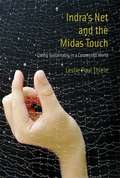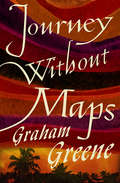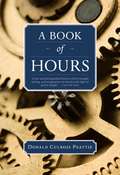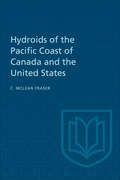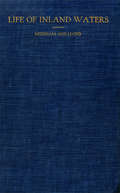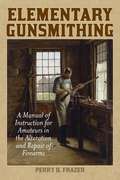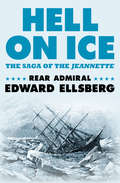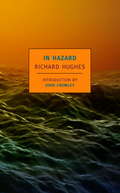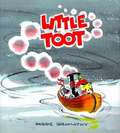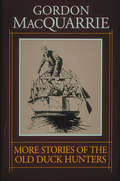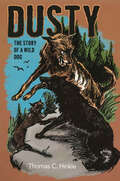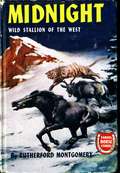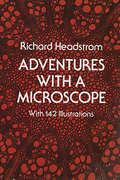- Table View
- List View
The History of American Sailing Ships
by Howard I. ChapelleThis is the first complete history published of the development of the various types of sailing vessels and rigs in America from Colonial craft to modern racing and cruising yachts.
Birds in the Wilderness: Adventures of an Ornithologist
by George Miksch SuttonTrained as an ornithologist and painter, George M. Sutton recounts a series of adventures with birds in the first decades of the twentieth century. In "Titania and Oberon" he tells the story of raising a pair of baby road-runners. In "The Harris's Sparrow's Eggs" he describes the fierce competition between U.S. and Canadian ornithologists who searched for the nest and eggs of a reclusive bird. In "Kints!" Sutton writes of observing and recording one of the last known nesting pairs of ivory-billed woodpeckers.
Carcajou: King of the North
by Rutherford MontgomeryCARCAJOU was determined to destroy every trap Two Gray Hills set. He bent forward eagerly, one powerful front paw lifted for a lightning stroke. The deadly muzzle of the gun stared blackly upon him." Carcajou, the wolverine — 30 pounds of diabolical cunning and snarling fury — feared by every killer from cougar to grizzly. Indian trappers say he is possessed of an evil spirit. Nature's forces take a hand when Carcajou declares war against Indian trapper Two Gray Hills, and when two deceitful traders plot to steal Two Gray Hills' pet bear.
Indra's Net and the Midas Touch
by Leslie Paul ThieleWe live today in a global web of interdependence, connected technologically, economically, politically, and socially. As a result of these expanding and deepening interdependencies, it has become impossible fully to control--or foretell--the effects of our actions. The world is rife with unintended consequences. Wall Street's reckless investment in toxic assets recently produced massive defaults and a global economic recession. Our attachment to fossil energy is producing a climate default. The first law of human ecology--which declares that we can never do merely one thing--is a truth we ignore at our peril. In Indra's Net and the Midas Touch, Leslie Paul Thiele explores the impact of interdependence and unintended consequences on our pursuit of sustainability. Unfortunately, good intentions provide no antidote to the law of unintended consequences, and proffered cures often prove worse than the disease. Biofuels developed for the purpose of cutting carbon emissions, for example, have had the unintended effect of cutting off food supplies to the needy and cutting down rainforests. The challenge we face is to be ingenious and adaptive in our pursuit of sustainability. But we cannot simply invent our way out of our ecological and economic crisis. Rather, we must fundamentally transform our patterns of thinking and behavior. Thiele offers the intellectual and moral foundations for this transformation, drawing from ecology, ethics, technology, economics, politics, psychology, physics, and metaphysics. Awareness of our interconnectedness, he writes, stimulates creativity and community; it is a profound responsibility and a blessing beyond measure.
Journey Without Maps: Una Aventura Por El Corazón De Liberia (Twentieth Century Classics Ser. #Vol. 7)
by Graham GreeneThe British author embarks on an awe-inspiring trek through 1930s West Africa in “one of the best travel books [of the twentieth] century” (The Independent). When Graham Greene left Liverpool in 1935 for what was then an Africa unmarked by colonization, it was to leave the known transgressions of his own civilization behind for those unknown. First by cargo ship, then by train and truck through Sierra Leone, and finally on foot, Greene embarked on a dangerous and unpredictable 350-mile, four-week trek through Liberia with his cousin, and a handful of servants and bearers, into a world where few had ever seen a white man. For Greene, this odyssey became as much a trip into the primitive interiors of the writer himself as it was a physical journey into a land foreign to his experience. “No one who reads this book will question the value of Greene’s experiment, or emerge unshaken by the penetration, the richness, the integrity of this moving record.” —The Guardian
A Book of Hours
by Donald Culross PeattieA Book of Hours contains 24 essays, one for each hour of the day, that seek to bridge the gap between definitive scientific philosophy and the sheer unadulterated beauty that Donald Culross Peattie envisioned within everyday life. The Boston Transcript referred to this collection as "science, in sheer poetry," and the Chicago Daily Tribune mused that "it leaves one a better man for having read it" and offers "the inevitableness of natural laws and the truth of beauty, if one cares to seek it."
A Book of Hours
by Donald Culross PeattieA Book of Hours contains 24 essays, one for each hour of the day, that seek to bridge the gap between definitive scientific philosophy and the sheer unadulterated beauty that Donald Culross Peattie envisioned within everyday life. The Boston Transcript referred to this collection as "science, in sheer poetry," and the Chicago Daily Tribune mused that "it leaves one a better man for having read it" and offers "the inevitableness of natural laws and the truth of beauty, if one cares to seek it."
Hydroids of the Pacific Coast of Canada and the United States
by Charles McLean FraserHydroids of the Pacific Coast of Canada and the United States is an attempt to give a brief description, with figures, of every hydroid species known to occur along the Pacific Coast of Canada and the United States, together with its distribution within this area. It is intended to provide the Pacific zoologist with a reference, easily understood, to every species of hydroid reported from the coast. Keys to families, genera, and species have been included to facilitate diagnosis. Much of the information presented has already been published, but in widely scattered papers, some of them long out of print. The new contribution is largely in the extensive addition to the distribution records, for which many thousands of specimens have been examined.
Life of Inland Waters: An Elementary Text Book of Fresh-Water Biology For Students
by James G. NeedhamThis work is a textbook of fresh-water life dealing with its forms, its conditions, its fitnesses, its associations, and its economic aspects. The ecologic side of fresh-water biology is emphasized. Due consideration is given to the educational, economic, sanitary, social, civic, and aesthetic aspects of the subject.Limnology in America today is in its infancy. The value of its past achievements is just beginning to be appreciated. The benefits to come from a more intensive study of water life arc just beginning to be disclosed. That there is a widespread interest is already manifest in the large number of biological stations at which limnological work is being done.We recommend this volume as a general introduction to all students and teachers of this subject.
The Terhune Omnibus
by Albert Payson Terhune Max J. HerzbergIn this collection of the work of Albert Pason Terhune, the author shares many of his favorite dog stories, as well, as some of the other stories of animal friends he has written over the years.
Yellow Eyes
by Rutherford MontgomeryYellow Eyes raised and faced about. His amber eyes shone and his ears were laid back. In an instant he struck again and sent the leader of the pack hurtling from the cliff. Against dogs, man, and natural enemies the fierce American cougar fights to keep his rule supreme in the high mountain country of the West.
Elementary Gunsmithing: A Manual of Instruction for Amateurs in the Alteration and Repair of Firearms
by Perry D. FrazerA beginner’s guide to the ins and outs of guncraftsmanship from a professional gunsmith.When it was first published in 1938, Elementary Gunsmithing was one of the few books of the time to address an amateur audience, among more advanced titles. With clear, engaging, and instructional prose, Frazer takes beginner firearm interest to the next level by talking the reader through the fundamentals of gunsmithing, such as what tools are necessary for the craft, how to solder and mount parts, and even how to conduct a fledgling gunsmithing business. He specifically addresses the "young man who likes working at the bench,” and similarly the book reflects the spirit of innovation, resourcefulness, and do-it-yourself work.While the book may not cover contemporary firearms, it offers a grandfatherly, old-school instructional vibe with accurate information about guns up to the 1940s. Frazer focuses on gunsmithing with ordinary hand tools at the work bench, rather than complicated machinery. These helpful tips and information, which are still applicable today, make Elementary Gunsmithing a useful, classic, and historically significant reference for both amateurs and budding gunsmithers keen on building a full-time business.Skyhorse Publishing is proud to publish a broad range of books for hunters and firearms enthusiasts. We publish books about shotguns, rifles, handguns, target shooting, gun collecting, self-defense, archery, ammunition, knives, gunsmithing, gun repair, and wilderness survival. We publish books on deer hunting, big game hunting, small game hunting, wing shooting, turkey hunting, deer stands, duck blinds, bowhunting, wing shooting, hunting dogs, and more. While not every title we publish becomes a New York Times bestseller or a national bestseller, we are committed to publishing books on subjects that are sometimes overlooked by other publishers and to authors whose work might not otherwise find a home.
Gray Wolf
by Rutherford MontgomeryLast of the great gray wolves--fleet, savage Speed, iron-jawed killer of the high country. Too cunning for poison and traps, too swift for men and dogs, he eludes every hunter. Can one of his own breed be trained to challenge him? What will happen when the two mighty lobos--father and son--meet in deadly battle?
Hell on Ice: The Saga of the Jeannette
by Rear Admiral Edward EllsbergBased on a true story: the thrilling tale of a ship&’s 1879 journey to explore the North Pole—and the crew&’s desperate attempt to escape an Arctic ice pack. In the 1870s, newspaperman James Gordon Bennett of the New York Herald drummed up excitement and publicity for his paper through highly publicized missions of exploration. In 1879, Bennett&’s idea for a voyage was his most audacious to date: the North Pole. To do this, he hired a team of naval veterans in addition to a smattering of civilians with specialized knowledge in meteorology, whaling, and naturalism. The men on board the Jeannette set off in September of 1879. This would be the last time anyone saw them for two years. The product of devoted research into personal histories, memoirs, and classified congressional investigation records, Hell on Ice is a remarkable document: a novelization of history, turning the horrible ordeal of the brave men of the Jeannette into a riveting narrative. Written with a weathered seaman&’s familiarity, the story brilliantly captures a most perilous voyage from the perspective of the ship&’s chief engineer. The men of the Jeannette endure months trapped in an Arctic ice pack, and then begin a desperate trek for home.
In Hazard
by Richard Hughes John CrowleyThe Archimedes is a modern merchant steamship in tip-top condition, and in the summer of 1929 it has been picking up goods along the eastern seaboard of the United States before making a run to China. A little overloaded, perhaps--the oddly assorted cargo includes piles of old newspapers and heaps of tobacco--the ship departs for the Panama Canal from Norfolk, Virginia, on a beautiful autumn day. Before long, the weather turns unexpectedly rough--rougher in fact than even the most experienced members of the crew have ever encountered. The Archimedes, it turns out, has been swept up in the vortex of an immense hurricane, and for the next four days it will be battered and mauled by wind and waves as it is driven wildly off course. Caught in an unremitting struggle for survival, both the crew and the ship will be tested as never before. Based on detailed research into an actual event, Richard Hughes's tale of high suspense on the high seas is an extraordinary story of men under pressure and the unexpected ways they prove their mettle--or crack. Yet the originality, art, and greatness of In Hazard stem from something else: Hughes's eerie fascination with the hurricane itself, the inhuman force around which this wrenching tale of humanity at its limits revolves. Hughes channels the furies of sea and sky into a piece of writing that is both apocalyptic and analytic. In Hazard is an unforgettable, defining work of modern adventure.
Swiss Holiday
by Elizabeth YatesA visit to Switzerland with their adventurous Uncle Tony brings Michael and Meredith new friends and an introduction to the art of mountain climbing.
Tiger Roan
by Glenn BalchThis book relates the adventures of a young roan stallion in the wild, as a bucking horse in the rodeo, and as a saddle horse working with the only man he ever trusts. He meets people who are cruel and care about him only for making money, and one man who is kind and trustworthy, but who must leave him for a time. Will they find each other again?
Black, Bay and Chestnut
by C. W. AndersonThis book gives profiles of twenty of the most famous horses of the day. From Man O'war, king of the race track, to Heatherbloom horse able to jump like Pegasus, to Bob the great milk horse these stories bring to light the personality and beauty of our four footed equine friends.
Little Toot
by Hardie GramatkyIn this Weekly Reader Children's Book Club selection, a tiny tug rescues a big ship.
More Stories of the Old Duck Hunters
by Gordon MacquarrieMasterpieces you can read over and over is how the Washington Post reviewed MacQuarrie's engaging, timeless stories of the misadventures of the Old Duck Hunters Association.<P><P>Here are 53 classic hunting and fishing stories, some from sporting magazines of the 1930s and 1940s, including unpublished works from the author's literary estate.
Dusty: The Story of a Wild Dog
by Thomas C. HinkleAt nine days of age a freak accident leaves Dusty, the wolfhound pup, separated from his mother. Old Gray, a she-wolf, adopts the lost pup after suffering her own tragedy. Old Gray raises Dusty and tries to instill in him the fear of man, but only partly succeeds. Besides the threat of man, the pair have numerous run-ins with two huge black wolves bent on destroying the mother and son. Young Matt Henderson then comes on the scene, and eventually catches and tames Dusty. The wolfhound proves himself to be invaluable to Matt. Finally, the black wolf and Dusty face off in one last fight. Join Dusty in his fight for survival.
Midnight (Famous Horse Stories)
by Rutherford MontgomeryLady Ebony is a beautiful mare owned by a rancher, with hopes of a racing career. Sam, a mountain man, has become fond of her and wants to buy her. But while Sam seeks funds from his secret stash, a vein of gold, Lady Ebony meets a band of wild horses and goes with them. Soon she has a colt with the band's leader, a wild chestnut stallion. The colt is Midnight. Lady Ebony teaches Midnight the ways of the wild, until one night she is killed. Without her, can Midnight grow to be a strong, confident stallion, or will he succumb to one of the many perils of the wild? This book is filled with beautiful descriptions of nature by noted wildlife author Rutherford Montgomery
Salute
by C. W. AndersonFrom the Book jacket: "If I only knew someone who would give him a good home." The owner of a fine horse, just crippled on the track, made the remark and Peter overheard him. Peter was ten and his father had taken him to his first race at Saratoga. He had always loved horses-Mohawk's owner could tell that from the way he acted. Could he take the horse? His father said he could, so a few days later Mohawk came home. Happy, busy days followed for both Peter and Mohawk, for no horse ever received more tender care. He grew strong and lively too. And when another year came around, he ran again and won $500. Perhaps you can guess what Peter did with his money. ... He bought a yearling, and, most exciting of all, Salute was a grandson of the great Man o' War. The artist's beautiful lithographs were all drawn directly on the zinc plates, a technique which gives them a rich depth in tone and quality. C. W. ANDERSON "Young horse lovers are extremely fond of C. W. Anderson's books. They have handsome horse portraits, and they tell in simple, straightforward fashion of the experience of children with horses." -New York Herald Tribune C. W. Anderson grew up in Wahoo, Nebraska, and studied at the Art Institute of Chicago. His first book, Billy and Blaze, was published by Macmillan in 1936. Since then more than half a million Billy and Blaze Books have been sold, and Mr. Anderson has come to be recognized as America's foremost author- illustrator of horse stories. He has written such favorites for young readers as A Filly for Joan and High Courage, as well as books for horse enthusiasts of all ages such as Heads Up, Heels Down, C. W. Anderson's Complete Book of Horses and Horsemanship, and Twenty Gallant Horses. Horses still dominate Mr. Anderson's life as an artist and sportsman. He has a country home in Mason, New Hampshire, where he rides, and a studio in Boston.
Adventures with a Microscope
by Richard HeadstromWith a simple microscope and this book, you can embark on 59 wonderful adventures in the natural world -- make discoveries about the structures of numerous microscopic animals; find out what everyday objects and foods really look like at the cellular level; gain an understanding of how to prepare specimens and slides; and learn about many scientific phenomena such as how a fly can walk upside down on the ceiling. It's all here in simple-to-understand language and 142 clear line drawings.The author first examines under the microscope such everyday objects as a human hair, air bubble, scale of a herring, poppy seed and sugar crystal, and then offers through-the-microscope views of such creatures and objects as the water flea, hydra, house fly, amoeba, euglena, volvox, diatoms, desmids, algae, blood corpuscles, honey bee, rotifer, water-mites, potato starch, and other food substances, lichen, paramecium, coffee, sponge, chalk, yeast, bacteria, mustard, pepper, bryozoan, moss, mushroom, molds, cotton, and other textile fibers, ferns, dragon-flies, flea, spider, roots, and other plant structures, paper, aphid, fingerprints, nervous system of the grasshopper, and more.Richard Headstrom, formerly associated with the New England Museum of Natural History and an experienced teacher and writer on natural science for young people, has made this book simple enough for any beginner at home as well as interesting for more experienced students and lay readers. Enjoyable and instructive, these adventures with a microscope will appeal to all who are curious about what there is to see beyond the range of the naked eye.
The Lost Campers (Sugar Creek Gang #4)
by Paul HutchensThe Sugar Creek Gang heads to Minnesota for a camping trip. There they discover a railroad coach in the middle of a forest without any railroad tracks, and an honest-to-goodness Indian with beads and a war bonnet. What are they to make of this?

